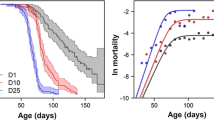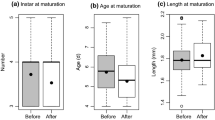Abstract
Models of resource allocation strategies predict an array of life-history responses of individuals living in resource-stressed versus non-stressed environments. I tested a number of these predictions using three fish strains (a sexual and two clonal strains) in high and low density treatments. To examine the plasticity of life-history traits in females raised in these two environments, I measured survival, growth, egg production, egg size, and proportion mature at 10 weeks of age. Survival was not affected by density treatment. However, both growth and overall egg production were lower in females from the high density treatments, and reproductive maturity was significantly delayed at the high density for all strains. Egg production per unit size was not affected by density in any strain, signifying that differences in the numbers of eggs produced was merely a reflection of the differences in size of fish in the two density treatments. Egg size was also unaffected by density in all strains. These results are related to models of resource allocation in stressful environments. There was a consistent pattern of increased reproductive investment in the sexual strain relative to the two clonal strains. The sexual strain matured earlier, produced more eggs per unit body weight, and had larger eggs than either clone at both densities. These results are interpreted by considering the predicted adaptive responses of these three strains to the long-term environmental differences in their natural habitats.
Similar content being viewed by others
References
Alm G (1959) Connection between maturity, size, and age in fishes. Rep. Inst. Freshwater Res. Drottingholm 40:1–145
Angus RA, Schultz RI (1983) Meristic variation in homozygous and heterozygous fish. Copeia 1983:287–299
Avise JC, Vrijenhoek RC (1987) Mode of inheritance and variation of mitochondrial DNA in hybridogenetic fishes of the genus Poeciliopsis. Mol Biol Evol 4:514–525
Bagenal TB (1969) The relationship between food supply and fecundity in brown trout Salmo trutta L. J Fish Biol 1:167–182
Brockelman WY (1975) Competition, the fitness of offspring, and optimal clutch size. Am Nat 109:677–699
Caswell H (1983) Phenotypic plasticity in life-history traits: Demographic effects and evolutionary consequences. Am Zool 23:35–46
Cimino MC (1972) Egg-production, polyploidization and evolution in a diploid all-female fish of the genus Poeciliopsis. Evolution 26:294–306
Dahlgren BT (1979) The effects of population density on fecundity and fertility in the guppy, Poecilia reticulata (Peters). J Fish Biol 15:71–91
Fisher RA (1930) The genetical theory of natural selection. Clarendon Press, Oxford
Gadgil M, Bossert WH (1970) Life historical consequences of natural selection. Am Nat 104:1–24
Giesel JT (1976) Reproductive strategies as adaptations to life in temporally heterogeneous environments. Ann Rev Ecol Syst 7:57–79
Hester FJ (1964) Effects of food supply on fecundity in the female guppy, Lebistes reticulatus (Peters). J Fish Res Bd Can 21:757–764
Hislop JRG, Robb AP, Gauld JA (1978) Observations on effects of feeding level on growth and reproduction in haddock, Melanogrammus aeglefinus (L.) in captivity. J Fish Biol 13:85–98
Hutchings JA (1991) Fitness consequences of variation in egg size and food abundance in brook trout, Salvelinus fontinalis. Evolution 45:1162–1168
King D, Roughgarden J (1982) Graded allocation between vegetative and reproductive growth for annual plants in growing seasons of random length. Theor Popl Biol 22:1–16
Kozlowski J, Wiegert RG (1986) Optimal allocation of energy to growth and reproduction. Theor Pop Biol 29:16–37
MacKay I, Mann KH (1969) Fecundity of two cyprinid fishes in the river Thames, Reading, England. J Fish Res Bd Can 26:2795–2805
McGinley MA, Temme DH, Geber MA (1987) Parental investment in offspring in variable environments: Theoretical and empirical considerations. Am Nat 130:370–398
Meffe GK (1987) Embryo size variation in mosquitofish: Optimality vs. plasticity in propagule size. Copeia 1987:762–768
Meffe GK (1990) Offspring size variation in Eastern mosquitofish (Gambusia holbrooki: Poeciliidae) from contrasting thermal environments. Copeia 1990:10–18
Meffe GK (1992) Plasticity of life-history characters in eastern mosquitofish (Gambusia holbrooki: Poecillidae) in response to thermal stress. Copeia 1992:94–102
Moore WS, Eisenbrey B (1979) The population structure of an asexual vertebrate, Poeciliopsis 2 monacha-lucida (Pisces: Poecillidae). Evolution 33:563–578
Morris DW (1985) Natural selection for reproductive optima. Oikos 45:290–292
Morris DW (1987) Optimal allocation of parental investment. Oikos 49:332–339
Pinhorn AT (1969) Fishery and biology of Atlantic cod (Gadus morhua) off the southwest coast of Newfoundland. J Fish Bd Can 26:3113–3164
Quattro JM, Weeks SC (1991) Correlations between egg size and energetic content within and among biotypes of the genus Poeciliopsis. J Fish Biol 38:331–334
Quattro JM, Avise JC, Vrijenhoek RC (1991) Molecular evidence for multiple origins of hybridogenetic fish clones (Poeciliidae: Poeciliopsis). Genetics 127:391–398
Reznick D (1981) “Grandfather effects”: The genetics of interpopulation differences in offspring size in the mosquito fish. Evolution 35:941–953
Reznick D (1982) Genetic determination of offspring size in the guppy (Poecilia reticulata). Am Nat 120:181–188
Reznick D (1983) The structure of guppy life histories: The trade off between growth and reproduction. Ecology 64:862–873
Reznick DN (1990) Plasticity in age and size at maturity in male guppies (Poecilia reticulata): An experimental evaluation of alternative models of development. J Evol Biol 3:185–203
Reznick D, Bryga H, Endler JA (1990) Experimentally induced life-history evolution in a natural population. Nature 346:357–359
Reznick D, Endler JA (1982) The impact of predation on life history evolution in Trinidadian guppies (Poecilia reticulata). Evolution 36:160–177
Rowe DK, Thorpe JE (1990) Suppression of maturation in male Atlantic salmon parr (Salmo salar L.) by reduction in feeding and growth during spring months. Aquaculture 86:291–313
SAS Institute Inc. (1985) SAS User's Guide: Statistics, Version 5 Edition. Cary, North Carolina
Schaffer WM (1974) Optimal reproductive effort in fluctuating environments. Am Nat 108:783–790
Schaffer WM, Inouye RS, Whittam TS (1982) Energy allocation by an annual plant when the effects of seasonality on growth and reproduction are decoupled. Am Nat 120:787–815
Schenck RA (1988) Ecological aspects of coexistence among sexual and asexual fishes of the genus Poeciliopsis Ph.D. dissert., Rutgers University, New Brunswick, New Jersey
Schenck RA, Vrijenhoek RC (1986) Spatial and temporal factors affecting coexistence among sexual and clonal forms of Poeciliopsis. Evolution 40:1060–1070
Scott DP (1962) Effect of food quantity on fecundity of rainbow trout, Salmo gairdneri. J Fish Res Bd Can 19:715–731
Schultz DL (1991) Parental investment in temporally varying environments. Evol Ecol 5:415–427
Schultz RJ (1969) Hybridization, unisexuality, and polyploidy in the teleost Poeciliopsis (Poeciliidae) and other vertebrates. Am Nat 103:605–619
Schultz RJ (1982) Competition and adaptation among diploid and polyploid clones of unisexual fishes. In: Dingle H, Hegmann JP (eds) Evolution and genetics of life histories. Springer-Verlag, New York, New York, pp 103–119
Schultz RJ, Fielding E (1989) Fixed genotypes in variable environments. In: Dawley RM, Bogart JP (eds) Evolution and ecology of unisexual vertebrates. Bulletin 466, New York State Museum, Albany, New York, pp 32–38
Sibley R, Calow P, Nichols N (1985) Are patterns of growth adaptive? J Theor Biol 112:553–574
Smith CC, Fretwell SD (1974) The optimal balance between size and number of offspring. Am Nat 108:499–506
Smith-Gill SJ (1983) Developmental plasticity: Developmental conversion versus phenotypic modulation. Am Zool 23:47–56
Stearns SC (1983a) A natural experiment in life-history evolution: Field data on the introduction of mosquitofish (Gambusia affinis) to Hawaii. Evolution 37:601–617
Stearns SC (1983b) The genetic basis of differences in life-history traits among six populations of mosquitofish (Gambusia affinis) that shared ancestors in 1905 Evolution 37:618–627
Stearns SC (1983c) The evolution of life-history traits in mosquitofish since their introduction to Hawaii in 1905: Rates of evolution, heritabilities, and developmental plasticity. Am Zool 23:65–75
Stearns SC, Crandall RE (1984) Plasticity for age and size at sexual maturity: A lifehistory response to unavoidable stress. In: Potts G, Wootton RJ (eds) Fish reproduction. Academic Press, London, pp 13–33
Stearns SC, Koella JC (1986) The evolution of phenotypic plasticity in life-history traits: Predictions of reaction norms for age and size at maturity. Evolution 40:893–913
Taylor BE, Gabriel W (1992) To grow or not to grow: Optimal resource allocation for Daphnia. Am Nat 139:248–266
Taylor PD, Williams GC (1984) Demographic parameters at evolutionary equilibrium. Can J Zool 62:2264–2271
Thibault RE (1974a) The ecology of unisexual and bisexual fishes of the genus Poeciliopsis: A study in niche relationships. Ph.D. dissert., University of Connecticut, Storrs, Connecticut
Thibault RE (1974b) Genetics of cannibalism in a viviparous fish and its relationship to population density. Nature 251:138–140
Thibault RE, Schultz RJ (1978) Reproductive adaptations among viviparous fishes (Cyprinodontiformes: Poeciliidae). Evolution 32:320–333
Thorpe JE, Talbot C, Miles MS, Keay DS (1990) Control of maturation in cultured Atlantic salmon Salmo salar in pumped seawater tanks, by restricting food intake. Aquaculture 86:315–326
Travis J (1993) Ecological genetics of life-history traits: Variation and its evolutionary significance. In: Real LA (ed) Ecological genetics. Princeton University Press, Princeton, New Jersey, (in press)
Trendall JT (1983) Life history variation among experimental populations of the mosquitofish, Gambusia affinis. Copeia 1983:953–963
Trexler JC, Travis J (1990a) Phenotypic plasticity in the sailfin molly, Poecilia latipinna (Pisces Poeciliidae). I. Field experiments. Evolution 44:143–156
Trexler JC, Travis J (1990b) Phenotypic plasticity in the sailfin molly, Poecilia latipinna (Pisces Poeciliidae). II. Laboratory experiment. Evolution 44:157–167
Via S, Lande R (1985) Genotype-environment interaction and the evolution of phenotypic plasticity. Evolution 39:505–522
Vrijenhoek RC (1972) Genetic relationships of unisexual-hybrid fishes to their progenitors using lactate dehydrogenase isozymes as gene markers (Poeciliopsis, Poeciliidae). Am Nat 106:754–766
Vrijenhoek RC, Angus RA, Schultz RI (1978) Variation and clonal structure in a unisexual fish. Am Nat 112:41–55
Weeks SC, Gaggiotti OE (1993) Patterns of offspring size at birth in clonal and sexual strains of Poeciliopsis (Poeciliidae). Copeia 1993 (in press)
Weeks SC, Quattro JM (1991) Life-history plasticity under resource stress in a clonal fish (Poeciliidae: Poeciliopsis). J Fish Biol 39:485–494
Wetherington JD, Weeks SC, Kotora RE, Vrijenhoek RC (1989) Genotypic and environmental components of variation in growth and reproduction of fish hemiclones (Poeciliopsis: Poeciliidae). Evolution 43:635–645
Williams GC (1966) Adaptation and natural selection. Princeton University Press, Princeton, NJ
Winkler DW, Wallin K (1987) Offspring size and number: A life history model linking effort per offspring and total effort. Am Nat 129:708–720
Wootton RJ (1973) The effect of size of food ration on egg production in the female three-spined stickleback, Gasterosteus aculeatus L. J Fish Biol 5:89–96
Author information
Authors and Affiliations
Rights and permissions
About this article
Cite this article
Weeks, S.C. Phenotypic plasticity of life-history traits in clonal and sexual fish (Poeciliopsis) at high and low densities. Oecologia 93, 307–314 (1993). https://doi.org/10.1007/BF00317871
Received:
Accepted:
Issue Date:
DOI: https://doi.org/10.1007/BF00317871




